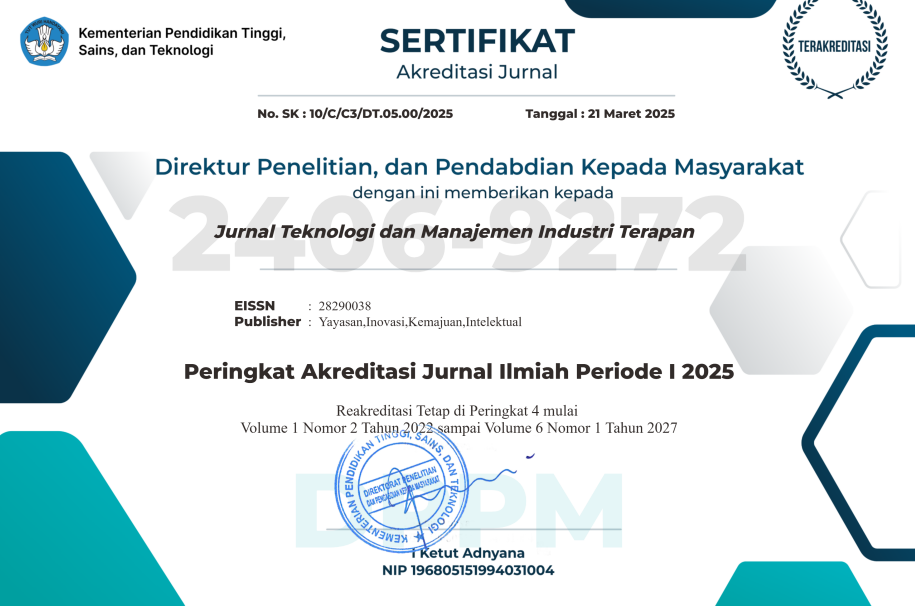Design Optimization of CNC Router 2413 for the Interior Design Industry Using Reverse Engineering and DFMA
DOI:
https://doi.org/10.55826/jtmit.v4i3.1148Keywords:
CNC Router 2413, Reverse Engineering, Design for Manufacturing and Assembly (DFMA), Industri Desain Interior, Optimasi DesainAbstract
The wood industry faces prolonged production times due to the use of conventional tools and the declining number of artisans. This study aims to design the CNC 2413 machine to meet the production needs of the interior design industry by improving efficiency, precision, and adaptability. The design process applies the Reverse Engineering approach combined with Design for Manufacturing and Assembly (DFMA). The key technical aspects include torque calculation, Center of Gravity (CoG) analysis, and assembly mapping. The results indicate that a 3-axis CNC router is sufficient for cutting and engraving tasks, requiring a minimum torque of 0.4116 N·m (Y-axis), 0.3528 N·m (X-axis), and 0.0156 N·m (Z-axis), with a spindle torque of 0.159 N·m. The Nema 24 stepper motor and Bosch GKF router were selected as they meet the specified requirements. The CoG analysis produced X = 56.9–63.0 cm, Y = 100.9–127.3 cm, and Z = 3.884 cm, demonstrating structural stability and resistance to vibration. This design is considered feasible and reliable for long-term use. In addition, the study offers practical significance in terms of potential production cost savings through lower power consumption compared to conventional machines and the opportunity to enhance the production capacity of small and medium enterprises (SMEs) in the interior design sector. This research provides a practical reference for developing CNC routers using locally sourced components, aligned with the technical and economic needs of the interior design industry.
References
C. Anam, K. M. Nur, K. Muzaka, and D. W. Wicaksono, “Penerapan Teknologi Mesin CNC Ukir/Router untuk Meningkatkan Nilai Ekonomis terhadap Produk Kerajinan dari Limbah Kayu Kelapa pada Kelompok UKM Desa Labanasem, Kabupaten Banyuwangi,” JPP IPTEK (Jurnal Pengabdian dan Penerapan IPTEK), vol. 8, no. 1, pp. 9–16, May 2024, doi: 10.31284/j.jpp-iptek.2024.v8i1.5267.
S. Yaghoubi and F. Rabiei, “A profound evaluation of different strategies to improve surface roughness of manufactured part in wood-CNC machining process,” Journal of Engineering Research (Kuwait), 2024, doi: 10.1016/j.jer.2024.05.033.
H. Pelit, M. Korkmaz, and M. Budakçı, “Surface Roughness of Thermally Treated Wood Cut with Different Parameters in CNC Router Machine,” Bioresources, vol. 16, no. 3, pp. 5133–5147, 2021, doi: 10.15376/biores.16.3.5133-5147.
Baju Bawono, T. Yuniarto, P. Anggoro Wisnu, and W. Dharsono Wahyu, “Optimasi Pengembangan Desain Ukiran Daun Pintu Presisi dan Unik pad Industri Kayu dengan Sentuan Artistic CAD/CAM,” 2024.
I. Wayan and A. Mahardika, “Pemberdayaan Industri Kecil Menengah Pengrajin Ukiran Kayu oleh Dinas Perindustrian dan Tenaga Kerja di Kabupaten Badung,” 2021.
A. Tasylichul Adib, “Populasi Hubungan antara Minat dan Kebahagiaan menjadi Perajin Ukir Kayu Jepara,” 2020.
N. Syifaur Rohmah and R. Salam, “Regenerasi Pengukir Muda dalam Keberlanjutan Industri Seni Ukir di Desa Mulyoharjo, Kecamatan Jepara, Kabupaten Jepara,” 2022. [Online]. Available: http://journal.unnes.ac.id/sju/index.php/SOSIOLIUM
Faris Reyhan Al Afif, “Evaluasi Kelancaran Proses Produksi untuk Meningkatkan Produktivitas di Perusahaan Mebel CV.XYZ,” 2024. [Online]. Available: http://ejurnal.unim.ac.id/
Y. Setyani and S. F. Nurhayati, “Strategi Pemasaran Usaha Mebel Home Industry UD Jati Mandiri Talunombo Baturetno Kabupaten Wonogiri,” 2025. [Online]. Available: https://jsr.lib.ums.ac.id/index.php/determinasi▪page105
M. Rosid Fatkhurrohman, Rahayu Kartika, and I. Indrawati Merita, “Rancang Bangun Mesin Pemotong Kayu Otomatis Berbasis Arduino,” 2021, [Online]. Available: https://ojs.unpkediri.ac.id/index.php/noe
Z. F. Hayat, S. P. Akuntansi, J. Akuntansi, N. Semarang, J. H. Sudarto, and T. Semarang, “Perhitungan Harga Pokok Produksi dengan Metode Harga Pokok Pesanan pada CV Mitra Bisnis Anda,” vol. 2, no. 1, 2019.
M. Soori, F. K. G. Jough, R. Dastres, and B. Arezoo, “Robotical Automation in CNC Machine Tools: A Review,” Sep. 01, 2024, Sciendo. doi: 10.2478/ama-2024-0048.
M. L. Sonjaya, M. Massaguni, and Muh. N. H. Amaluddin, “Reducing Cycle Time in the Manufacturing Process of Circular Pattern Interpolar Products (CPIP) Using Special Fixtures on a 3-Axis CNC Machine,” INTEK: Jurnal Penelitian, vol. 10, no. 2, pp. 131–136, Oct. 2023,doi: 10.31963/intek.v10i2.4 439.
A. Rakic, S. Zivanovic, Z. Dimic, and M. Knezevic, “Digital Twin Control of Multi-Axis Wood CNC Machining Center Based on LinuxCNC,” 2021.
A. Budhi, M. Taufik Qurahman, and A. Rasyid, “Desain Mesin CNC Router 3 Axis Berbantu Perangkat Lunak Autodesk Inventor,” Nozzle : Journal Mechanical Engineering, vol. 10, no. 1, 2021.
A. A. Sneineh, W. A. Salah, B. A. Zneid, M. Elnaggar, and M. Abuhelwa, “Development and Evaluation of a Low-Cost CNC Wood Carving Machine for Artisanal Applications,” Journal of Robotics and Control (JRC), vol. 6, no. 2, pp. 615–623, 2025, doi: 10.18196/jrc.v6i2.25554.
N. Y. D. Setyaningsih, K. Annudin, and Solekhan, “The influence of ruggedness reviews 3-dimensional photo carving media based on 3-Axis CNC router,” May 01, 2021, Department of Agribusiness, Universitas Muhammadiyah Yogyakarta. doi: 10.18196/jrc.2381.
N. Alfathan Banoel, D. Kusuma Wijaya, and T. Talitha, “Metode Taguchi Untuk Optimasi Proses Engraving CNC Router G-Weike WK1212 untuk Kayu Mahoni Taguchi Method For Engraving Process Optimization CNC Router G-Weike WK1212 for Mahogany,” 2021.
A. Rahman et al., “Analisa Penggunaan Mesin CNC Router 3 Axis Untuk Rintisan Usaha Souvenir,” Jurnal PROTEMAN: Professional Technology and Manufacturing, Volume 1 No 1 Tahun 2024.
N. Faqih, I. Sekaring Bumi, and W. Herwindo, “Peningkatan Produktivitas UMKM dengan Optimalisasi Penggunaan Mesin CNC di Kalibeber Wonosobo Provinsi Jawa Tengah,” Jurnal Diseminasi Konstruksi, vol. 1, no. 1, pp. 40–49, May 2024, doi: 10.56911/jdk.v1i1.104.
M. Soori, B. Arezoo, and R. Dastres, “Machine learning and artificial intelligence in CNC machine tools, A review,” Sustainable Manufacturing and Service Economics, vol. 2, p. 100009, Apr. 2023, doi: 10.1016/j.smse.2023.100009.
Sunarto, Hartono, Carli, Daryadi, B. Tjahjono, and T. Setiyawan, “Desain dan Pembuatan Mesin CNC Milling untuk Pembuatan Ukiran Kerajinan Kayu,” 2022. [Online]. Available: https://jurnal.polines.ac.id/index.php/rekayasa
A. Nugroho and Sujadi, “Pengaruh Penggunaan Mesin CNC Router terhadap Waktu Standar Pengerjaan Ornamen Desain Interior,” Jurnal Rekayasa Sistem Industri, Volume 4. No.2 Mei 2019.
M. A. Nurdianto and R. Fitriadi, “Perancangan Ulang Part Lengan Mesin CNC Mini Router Menggunakan Metode Reverse Engineering,” 2022. [Online]. https://eprints.ums.ac.id/117239/11/NASKAH%20PUBLIKASI%20%2819%29.pdf
N. Mahru Attin, “Redesain Kursi Operator Jahit dengan Metode Reverse Engineering (Studi Kasus: UMKM Sidayu),” Jurnal Sistem Teknik Industri, Vol. 1 No. 2 (2020).
Abdurrahman, I. Malik, and A. Zamheri, “Penerapan Metode Design for Manufacturing pada Rancang Bangun CNC Milling 3 Sumbu,” vol. 4, no. 2, pp. 2723–3359, 2023, doi: 10.5281/zenodo.8049149.
D. K. Wijaya, H. Suprijono, H. A. Santoso, K. Kusmiyati, and M. A. R. Muchti, “Design for Manufacturing and Assembly Optimization of Home-Scale Biodigester-Composter Using VDI 2222 and Finite Element Analysis Methods,” Jurnal Teknik Industri, vol. 26, no. 2, pp. 157–170, Sep. 2024, doi: 10.9744/jti.26.2.157-170.
Downloads
Published
Issue
Section
License
Copyright (c) 2025 Chandra Ramadhan, Dewa Kusuma Wijaya, Rudi Tjahyono

This work is licensed under a Creative Commons Attribution-NonCommercial-ShareAlike 4.0 International License.


















